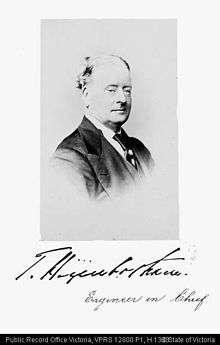Thomas Higinbotham
| Thomas Higinbotham | |
|---|---|
 PORTRAIT OF T HIGINBOTHAM, Engineer in Chief | |
| Born |
1819 Dublin |
| Died |
5 September 1880 (aged 61) St. Kilda-street, West Brighton, Victoria |
| Nationality | English |
| Education | Castle Dawson School and Royal Dublin Society House |
|
Engineering career | |
| Discipline | civil engineer |
| Projects | Bendigo railway line, Outer Circle railway line, Victoria |
Thomas Higinbotham (1819 – 5 September 1880), engineer and civil servant, was born in Dublin, the third son of Henry Higinbotham, merchant, and his wife Sarah, née Wilson.
Education and training
Educated in Dublin at Castle Dawson School and the Royal Dublin Society House, Higinbotham moved to London about 1839 initially working for a firm that promoted railway companies, and often appeared before parliamentary committees on railways, then as an engineer on British railroads, where he gained high repute in his profession.[1] In about 1838-9 he moved to London and entered the office of Sir William Cubitt, who was mentor to several Victorian railway engineers. Subsequently he was appointed as assistant-engineer of the South Eastern Railway, between Dover and Canterbury. Afterwards Sir Wm. Cubitt, who was advising engineer to the Great Northern Railway Company, had him appointed as resident engineer of that railway He was elected a member of the Institution of Civil Engineers on 7 February 1854.[2]

Migration to Australia
He moved to Melbourne, Australia in 1857, living with his eldest brother George's household in Melbourne. He never married.
In 1860 became engineer-in-chief of the Victorian Railways replacing the first engineer George Christian Darbyshire. He supervised the surveying and construction of all new Victorian lines and championed various rail improvements including city station locations, construction of Melbourne's outer-circle railway and adaptations to permit unbroken rail traffic between Sydney and Melbourne. He was removed from office in January 1878 by the Berry government and replaced by Robert Watson but invited by the South Australian, Tasmanian and New Zealand governments to report on their railway systems.
Final year
In March 1880 the Service government reappointed him engineer-in-chief of the Victorian railways, but the ministry soon fell and he was unhappy under its successor. He had decided to resign but died in his sleep on 5 September, to be replaced as Engineer-in-Chief by William Elsdon.[3]
His long standing and status in the department was rewarded on his retirement by a sumptuous banquet and presentation.
References
- ↑ R. L. Wettenhall, 'Higinbotham, Thomas (1819–1880)', Australian Dictionary of Biography, National Centre of Biography, Australian National University, published in hardcopy 1972, accessed online 30 June 2014
- ↑ "Death Of Mr. Thomas Higinbotham.". The Argus (Melbourne, Vic. : 1848-1954). Melbourne, Vic.: National Library of Australia. 6 September 1880. p. 7. Retrieved 13 July 2011.
- ↑ "Sketches with Pen.". The Australasian Sketcher with Pen and Pencil (Melbourne, Vic. : 1873-1889). Melbourne, Vic.: National Library of Australia. 11 September 1880. p. 230. Retrieved 13 July 2011.
Bibliography
- Wettenhall, R. L. 'Higinbotham, Thomas (1819–1880)', Australian Dictionary of Biography, Volume 4, Melbourne University Press, 1972, pp 397–398.
- Cumming, D.A. Some Public Works Engineers in Victoria in the Nineteenth Century Technology Report No. TR-85/10. August 1985.
- 'Obituary: Mr. Thomas Higinbotham, M.I.C.E.', Transactions and Proceedings of the Royal Society of Victoria, vol 17, 1880, pp 91–92;
- 'Obituary' The Age (Melbourne), 6 Sept 1880;